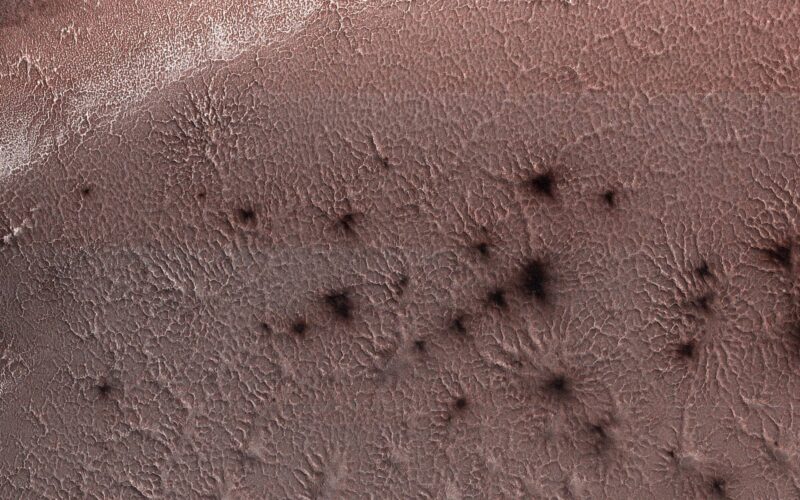Trinity researchers today published the first physical evidence of how unique, spider-like features on the surface of Mars are formed.
The team from Trinity in collaboration with Durham University and the Open University conducted experiments under simulations of Mars’ atmosphere to determine how the patterns are formed. The “spiders from Mars”, formally termed araneiforms, are patterns on Mars’ surface that look similar to radiating forks of lightning or tree branches.
In their paper, which appeared in the scientific journal Nature, these researchers investigated the hypothesis that araneiforms are created by frozen carbon dioxide (CO2) changing directly from solid to gas as temperatures on Mars rise in the spring, a process called sublimation. They successfully created the first set of physical evidence for formation of araneiforms via sublimation under conditions similar to Mars’ atmosphere.
Dr Lauren McKeown led this research while conducting her PhD in Trinity and is lead author on the Nature paper.
“The experiments show directly that the spider patterns we observe on Mars from orbit can be carved by the direct conversion of dry ice from solid to gas”, said Dr McKeown in a press statement today. “It is exciting because we are beginning to understand more about how the surface of Mars is changing seasonally today.”
These formations are not found on Earth because Mars’ atmosphere is made up primarily of CO2 rather than oxygen and nitrogen like Earth.
The prevailing hypothesis for how the araneiforms arise on Mars, known as Kieffer’s hypothesis, proposes that the sun hitting the frozen CO2 on Mars’ surface would cause it to turn to gas at the ice’s base, thus creating enough pressure to crack the ice and allow CO2 gas and the dusty material of Mars’ surface to escape. This release of pressure would then create the characteristic spider-like patterns on the planet’s surface.
Prior to the work of Dr McKeown and colleagues published today, this hypothesis was entirely theoretical. Their experiments involved drilling a hole in a CO2 ice block, suspending the block over various sandy beds and reducing the pressure to that of Mars’ atmosphere. When the ice came in contact with the sand, it sublimated and released a gas and sand plume through the hole as predicted, and spider formations were created.
As the very first empirical evidence for this process, Trinity researchers’ findings will be useful for simulating other processes on Mars’ surface and examining the role of this process on other planets and moons.
Dr Mary Bourke of Trinity’s Department of Geography supervised the PhD research, and said in a press statement today: “This innovative work supports the emergent theme that the current climate and weather on Mars has an important influence not only on dynamic surface processes, but also for any future robotic and/or human exploration of the planet.”
The research was funded by the Irish Research Council and Europlanet and conducted at the Open University Mars Simulation Chamber. Its detailed findings can be found in the open access publication titled “The Formation of Araneiforms by Carbon Dioxide Venting and Vigorous Sublimation Dynamics Under Martian Atmospheric Pressure.”







